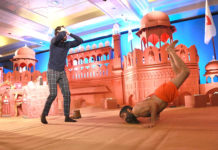Untitled (I shop therefore I am), 1987 (Photographic Silkscreen/Vinyl)
Artist: Barbara Kruger

This piece is characteristic of Kruger’s early work, depicting a phrase placed over a photographic image from a newspaper or magazine. Kruger first worked in magazine advertising, and used her graphic design expertise in her art. The slogan in this work refers to images of women in the media, specifically product advertisements designed for women, which are usually created by men. It is a reminder that most of the media that is geared toward women is based on men’s assumptions about women’s desires, lives and ideals, interrogating the belief that women only need material objects to feel happy and that men can keep them under their control by those means. Kruger’s work is accessible and direct, and was incredibly influential among the artists of the 1980s.
The Advantages of Being a Woman Artist, 1989 (Poster)
Artist: The Guerrilla Girls

Artwork description & Analysis: This is one of the Guerrilla Girls’ early posters, and exemplifies their strategy of using humor to defuse and break down discrimination and prejudice within the art world. Adopting a tongue-in-cheek tone, they list the “advantages” that still faced women artists in the late 1980s, like “Knowing your career might pick up after you’re eighty.” Guerilla Girl “Lee Krasner” stated, “The world of High Art, the kind that gets into museums and history books, is run by a very small group of people. Our posters have proved over and over again that these people, no matter how smart or good-intentioned, have been biased against women and artists of colour.” This poster reflects how pervasive that bias was in 1989, despite almost two decades of feminist activism. The fact that the Guerrilla Girls are still making posters and appearing globally implies that this problem still persists today.
Yard, 1961 (Tires), Movement: Happenings
Artist: Allan Kaprow


Yard by Kaprow involved the random scattering and piling of tires over the floor and an invitation to visitors to climb over them. This piece was supposedly in response to Jackson Pollock’s “drip” paintings: the incorporation of chance as a mainstay of the work, but with a certain amount of control left to the artist. Just as Pollock had a certain amount of power over his drip paintings, aesthetics were still very much subject to chance. Here Kaprow used the tires as Pollock used his paint. The result – a haphazard pile of tires nevertheless circumscribed into a semblance of compositional order – is a three-dimensional translation of Pollock’s practice. Kaprow’s pieces often involved materials from everyday life, including people; Kaprow stated, “Life is much more interesting than art.” Yard, like many ‘Happenings’, has been recreated several times since Kaprow’s initial installation, and each time a unique artwork is produced.
Top -Jackson Pollock’s “drip” paintings, Image courtesy: photonlab.com, Bottom -Yard, Image courtesy: artsjournal.com
One and Three Chairs, 1965 (Wood folding chair, mounted photograph of a chair, and photographic enlargement of a dictionary definition of “chair” – The Museum of Modern Art, New York), Movement: Conceptual Art
Artist: Joseph Kosuth


A physical chair sits between a scale photograph of a chair and a printed definition of the word “chair.” Emblematic of Conceptual art, One and Three Chairs makes people question what constitutes the “chair” – the physical object, the idea, the photograph or a combination of all three. Joseph Kosuth once wrote, “The art I call conceptual is such because it is based on an inquiry into the nature of art. Thus, it is…a thinking out of all the implications, of all aspects of the concept ‘art.'” One and Three Chairs denies the hierarchical distinction between an object and a representation, just as it implies a conceptual work of art can be object or representation in its various forms. This work harks back to and also extends the kind of inquiry into the presumed priority of object over representation that had been earlier proposed by the Surrealist Rene Magritte in his Treachery of Images (1928-29), with its image of a pipe over the inscription “Ceci n’est pas un pipe” (This is not a pipe).
Image courtesy: pinimg.com (top), wikiart.org (bottom)
“Untitled” (Loverboy), 1989
Artist: Felix Gonzalez-Torres

The work of the Cuban artist Felix Gonzalez-Torres addresses many postmodernism issues including originality, the importance of the viewer, the concern with minority identities, and the ephemeral nature of art. “Untitled” (Loverboy), is a stack of paper, from which visitors are encouraged to take a piece. The installation instructions give specific directions to maintain the stack at a certain weight. While the pile shrinks on a daily basis as visitors – with some trepidation – take paper from the pile, it is restored to its full size each morning. Thus, there is no solid, commoditised, always-existing work of art in the traditional sense; it is reconstructed at each installation site with new paper, and the entire piece reconstituted. The work thus questions originality and authorship, while involving the viewer very profoundly in the meaning of the work, which is about the death of Gonzalez-Torres’ lover, Ross, from AIDS. As the weight of the pile of paper shrinks each day, this diminution represents Ross’s wasting away from the AIDS virus, which he died from two years after the work was first shown. Thus the piece also deals with issues important to the LGBT community – a minority group of people whose rights were just beginning to be recognised.
Featured image courtesy: pietmondriaan.com




























